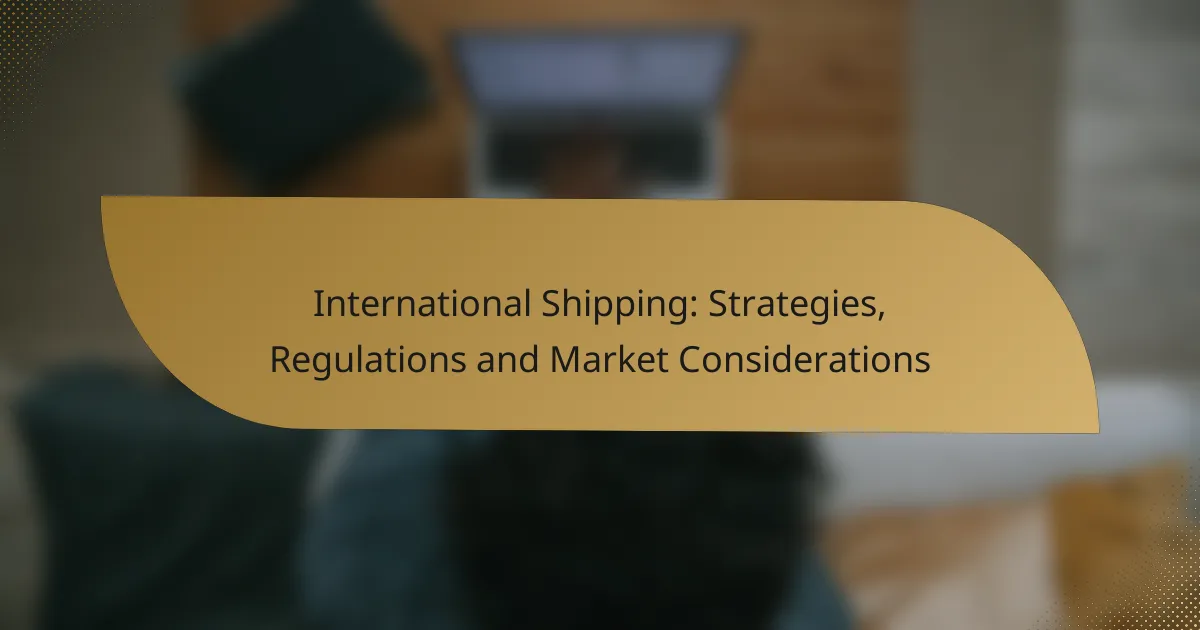International shipping is a critical component of global e-commerce, requiring strategies that prioritize cost efficiency, speed, and reliability. Navigating the complex landscape of regulations, including customs and tariffs, is essential for compliance and minimizing delays. Selecting the right shipping partner can further enhance logistics efficiency and improve customer satisfaction, making it a vital consideration for businesses engaged in international trade.

What are the best international shipping strategies for e-commerce?
The best international shipping strategies for e-commerce focus on cost efficiency, speed, and reliability. Implementing effective logistics solutions can enhance customer satisfaction and streamline operations.
Utilizing third-party logistics providers
Third-party logistics (3PL) providers can significantly simplify international shipping for e-commerce businesses. By outsourcing warehousing, fulfillment, and shipping, companies can reduce overhead costs and improve delivery times.
When selecting a 3PL, consider their global reach, technology integration, and customer service. Look for providers that have experience in your specific market and can handle customs regulations efficiently.
Implementing multi-carrier shipping solutions
Multi-carrier shipping solutions allow businesses to choose the most suitable carrier for each shipment, balancing cost and delivery speed. By integrating multiple carriers, e-commerce companies can optimize their shipping strategy based on destination, weight, and service level.
Consider using software that compares rates and delivery times from various carriers. This approach can lead to significant savings and improved customer satisfaction by providing more flexible shipping options.
Optimizing packaging for cost efficiency
Efficient packaging can reduce shipping costs and minimize damage during transit. Use lightweight materials and design packages that fit the product snugly to avoid excess dimensional weight charges.
Evaluate your packaging strategy regularly. Consider using biodegradable materials or reusable packaging to appeal to environmentally conscious consumers while potentially reducing costs.
Leveraging technology for tracking and management
Technology plays a crucial role in international shipping by providing real-time tracking and management capabilities. Implementing a robust shipping management system can help streamline operations and enhance visibility throughout the shipping process.
Utilize tracking tools that allow customers to monitor their shipments. This transparency can improve customer trust and reduce inquiries about order status, ultimately enhancing the overall shopping experience.

What regulations impact international shipping?
International shipping is influenced by various regulations that govern customs, import/export restrictions, and tariffs. Understanding these regulations is crucial for ensuring compliance and avoiding delays or additional costs during the shipping process.
Customs regulations in the EU
Customs regulations in the European Union (EU) require that all goods entering or leaving member states comply with specific documentation and tariff classifications. Importers must provide accurate declarations, including invoices and transport documents, to avoid penalties.
Additionally, the EU has established a common customs tariff that applies to goods imported from outside the EU. Importers should be aware of the applicable duties, which can vary significantly based on the product category and origin.
Import/export restrictions in Asia
Many Asian countries impose strict import and export restrictions that can affect international shipping. These regulations often include licensing requirements, quotas, and bans on certain goods, which vary by country.
For example, China has specific regulations on the import of agricultural products and technology. Exporters must ensure they comply with local laws to avoid confiscation or fines. It is advisable to consult local customs authorities or trade experts before shipping.
Tariffs and duties in North America
In North America, tariffs and duties are imposed on imported goods based on their classification under the Harmonized System. The United States and Canada have agreements that can reduce tariffs for certain goods, but these benefits depend on meeting specific criteria.
Businesses should calculate potential duties before shipping to avoid unexpected costs. Utilizing a customs broker can help navigate the complexities of tariffs and ensure compliance with regulations across different states and provinces.

How to choose the right shipping partner?
Choosing the right shipping partner involves assessing their reliability, speed, rates, and customer service. A well-chosen partner can significantly enhance your logistics efficiency and customer satisfaction.
Evaluating carrier reliability and speed
Carrier reliability refers to the consistency of a shipping partner in delivering goods on time and in good condition. Look for carriers with a strong track record, ideally with performance metrics available, such as on-time delivery rates above 95%.
Speed is also crucial, especially for time-sensitive shipments. Consider the average transit times for different carriers; for instance, express services may deliver within 1-3 days, while standard shipping might take 5-10 days. Evaluate whether the speed aligns with your business needs.
Comparing shipping rates and services
Shipping rates can vary widely based on factors like distance, weight, and service level. Obtain quotes from multiple carriers to compare costs effectively. Look for hidden fees such as fuel surcharges or customs duties that might affect the total price.
Consider the range of services offered by each carrier. Some may provide additional options like tracking, insurance, or specialized handling for fragile items. Weigh the benefits of these services against their costs to find the best value.
Assessing customer service and support
Strong customer service is essential for resolving issues that may arise during shipping. Evaluate the availability of support channels, such as phone, email, or live chat, and check if they offer 24/7 assistance.
Read reviews and testimonials to gauge the experiences of other customers. A carrier with responsive and helpful support can save you time and stress, especially when dealing with delays or lost shipments.

What are the costs associated with international shipping?
The costs of international shipping encompass various fees, including shipping fees, customs duties, taxes, and insurance. Understanding these costs is crucial for businesses and individuals to budget effectively and avoid unexpected expenses.
Understanding shipping fees and surcharges
Shipping fees are the primary costs associated with transporting goods internationally. These fees can vary significantly based on factors such as the shipping method (air, sea, or land), the weight and dimensions of the package, and the destination country.
In addition to standard shipping fees, surcharges may apply for fuel, peak seasons, or specific handling requirements. It’s essential to inquire about these additional charges when obtaining quotes from shipping carriers to get a complete picture of the total shipping costs.
Calculating customs duties and taxes
Customs duties and taxes are government-imposed fees on imported goods, calculated based on the item’s value, classification, and country of origin. Each country has its own tariff rates, which can range from a few percent to over 20% of the item’s value.
To estimate customs duties, you can use online duty calculators or consult with a customs broker. It’s advisable to factor these costs into your overall shipping budget to avoid surprises upon delivery.
Estimating insurance costs for shipments
Insurance costs for international shipments provide protection against loss or damage during transit. The cost of insurance typically ranges from 1% to 3% of the declared value of the goods, depending on the shipping carrier and the level of coverage chosen.
When shipping high-value items, consider purchasing additional insurance to mitigate potential losses. Always review the terms and conditions of the insurance policy to understand what is covered and any exclusions that may apply.

How to handle returns in international shipping?
Handling returns in international shipping involves clear policies, efficient logistics, and customer communication. Establishing a straightforward return process can enhance customer satisfaction and streamline operations.
Establishing a clear return policy
A clear return policy is essential for international shipping as it sets expectations for customers regarding how returns are processed. This policy should outline the time frame for returns, acceptable conditions for items, and any associated costs, such as restocking fees or return shipping expenses.
Consider including specific details about international regulations that may affect returns, such as customs duties or taxes. Providing this information upfront can help mitigate confusion and ensure compliance with local laws.
Utilizing return shipping labels
Providing return shipping labels simplifies the return process for customers and can significantly reduce the likelihood of lost packages. These labels can be pre-paid or include instructions for customers to print their own, depending on your business model.
When creating return labels, ensure they comply with international shipping standards. This includes using the correct customs declaration forms and ensuring the label is easily scannable to facilitate tracking.
Managing reverse logistics effectively
Effective reverse logistics is crucial for handling returns efficiently in international shipping. This involves planning how returned items will be processed, inspected, and restocked or disposed of, depending on their condition.
Consider partnering with logistics providers that specialize in reverse logistics to streamline the process. Regularly review your return data to identify trends and areas for improvement, which can help reduce return rates and enhance customer satisfaction over time.

What are the emerging trends in international shipping?
Emerging trends in international shipping include a strong focus on sustainability and the significant impact of e-commerce on logistics. These trends are reshaping how goods are transported globally, influencing practices and operational strategies.
Growth of sustainable shipping practices
Sustainable shipping practices are gaining traction as companies aim to reduce their environmental footprint. This includes adopting cleaner fuels, optimizing routes to minimize emissions, and investing in energy-efficient vessels. Many shipping companies are now setting ambitious targets to achieve carbon neutrality by the mid-2030s.
For instance, the International Maritime Organization (IMO) has set regulations to reduce greenhouse gas emissions from shipping by at least 50% by 2050 compared to 2008 levels. Companies are exploring technologies like wind-assisted propulsion and alternative fuels such as LNG and hydrogen to meet these goals.
Impact of e-commerce on shipping logistics
The rise of e-commerce has transformed shipping logistics, leading to increased demand for faster and more flexible delivery options. Retailers are now expected to offer same-day or next-day shipping, which requires efficient supply chain management and advanced logistics solutions.
To adapt, shipping companies are investing in automation and technology, such as AI-driven route optimization and real-time tracking systems. This shift not only enhances customer satisfaction but also streamlines operations, reducing costs and improving delivery times.
